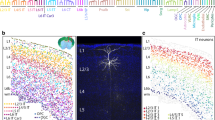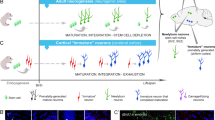Summary
The ultrastructure of axonal and dendritic growth cones has been examined in the cerebellar cortex of 7 days old rats and 12 days old cats. The unique feature is a bulge of the perikaryon surface or a varicosity of the growing tip of nerve processes. These cone-like areas contain large amounts of tubular smooth surfaced endoplasmic reticulum (SR) and large vacuoles. They are further characterized by filopodia (Tennyson, 1970) with a fibrillary matrix. Early cell contacts with synaptic membrane specializations are described between filopodia of mossy fiber endings and dendritic growth cones of granular cells. Synaptic vesicles appear early in synaptogenesis. While both vesicles and SR tubules are confined to separate areas of the axonal growth cone it was found that a common affinity to the ZIO staining agent exists. In contrast, the neurofilaments and microtubular components as well as the growth cone vacuoles remain consistently ZIO negative.
Similar content being viewed by others
References
Aghajanian, G. K., Bloom, F. E.: The formation of synaptic junctions in developing rat brain: A quantitative electron microscopic study. Brain Res. 6, 716–727 (1967).
Akert, K., Kawana, E., Sandri, C.: ZIO positive and ZIO negative vesicles in nerve terminals. In: Histochemistry of nervous transmission (O. Eränkö, ed.). Progr. Brain Res. Amsterdam: Elsevier (in press).
Bodian, D.: Development of fine structure of spinal cord in monkey fetuses. I. The motoneuron neuropil at the time of onset of reflex activity. Bull. Johns Hopk. Hosp. 119, 129–149 (1966).
—, Melby, E. C., Jr., Taylor, N.: Development of fine structure of spinal cord in monkey fetuses. II. Pre-reflex period to period of long intersegmental reflexes. J. comp. Neurol. 133, 113–166 (1968).
Buckley, I. K., Porter, K. R.: Cytoplasmic fibrils in living cultured cells. A light and electron microscopical study. Protoplasma 64, 349–380 (1967).
Bunge, M. B., Bunge, R. P., Peterson, E. R.: The onset of synapse formation in spinal cord cultures as studied by electron microscopy. Brain Res. 6, 728–749 (1967).
Bunge, R. P., Bunge, M. B., Peterson, E. R.: An electron microscope study of cultured rat spinal cord. J. Cell Biol. 24, 163–191 (1965).
Burnstock, G., Mark, G., Chamley, J., McConnell, J.: Time-lapse film on the formation of nervemuscle relationships in joint tissue cultures of smooth muscle and sympathetic nerves. In: Histochemistry of nervous transmission (O. Eränkö, ed.). Prog. Brain Res. Amsterdam: Elsevier (in press).
Cajal, S. Ramon y.: Histologie du système nerveux de l'homme et des vertébrés. Translated by L. Azoilay, Paris, Reissued 1952 by Consejo Superior de Investigaciones Cientificas, Madrid, chap. XXI, vol. 1, p. 589, 1909.
Danneel, S.: Identifizierung der kontraktilen Elemente im Cytoplasma von Amoeba proteus. Naturwissenschaften 51, 368–369 (1964).
Del Cerro, M. P., Snider, R. S.: Studies on the developing cerebellum. Ultrastructure of the growth cones. J. comp. Neurol. 133, 341–362 (1968).
Fawcett, D. W.: The atlas of fine structure: The cell. Its organelles and inclusion. Philadelphia and London: W. B. Saunders Comp. 1966.
Glees, P., Sheppard, B. L.: Electron microscopical studies of the synapse in the developing chick spinal cord. Z. Zellforsch. 62, 356–362 (1964).
Gray, E. G.: The granule cells, mossy synapses and Purkinje spine synapses of the cerebellum: light and electron microscope observations. J. Anat. (Lond.) 95, 345–356 (1961).
Grimstone, A. V.: Structure and function in protozoa. Ann. Rev. Microbiol. 20, 131–150 (1966).
Hámori, J., Dyachkova, L. N.: Electron microscope studies on developmental differentiation of ciliary ganglion synapses in the chick. Acta biol. Acad. Sci. hung. 15, 213–230 (1964).
Ito, S.: The endoplasmic reticulum of gastric parietal cells. J. biophys. biochem. Cytol. 11, 333–347 (1961).
Karnovsky, M. J.: Simple methods for “staining” with lead at high pH in electron microscopy. J. biophys. biochem. Cytol. 11, 729–732 (1961).
Kawana, E., Akert, K.: Zinc-iodide osmium tetroxide impregnation of nerve terminals during growth and secondary degeneration. In: Microscopie électronique (P. Favard ed.). 7th Congr. Int. de Microscopie Electronique, Grenoble, vol. I, p. 407–408, 1970.
— —, Sandri, C.: Zinc iodide-osmium tetroxide impregnation of nerve terminals in the spinal cord. Brain Res. 16, 325–331 (1969).
Meller, K.: Elektronenmikroskopische Befunde zur Differenzierung der Rezeptorzellen und Bipolarzellen der Retina und ihrer synaptischen Verbindungen. Z. Zellforsch. 64, 733–750 (1964).
—, Haupt, R.: Die Feinstruktur der Neuro-, Glio- und Ependymoblasten von Hühnerembryonen in der Gewebekultur. Z. Zellforsch. 76, 260–277 (1967).
Mugnaini, E.: The relation between cytogenesis and the formation of different types of synaptic contact. Brain Res. 17, 169–179 (1970).
Nakai, J., Kawasaki, Y.: Studies on the mechanism determining the course of nerve fibers in tissue culture. I. The reaction of the growth cone to various obstructions. Z. Zellforsch. 51, 108–122 (1959).
Ochi, J.: Elektronenmikroskopische Untersuchungen des Bulbus olfactorius der Ratte während der Entwicklung. Z. Zellforsch. 76, 339–348 (1967).
Palay, S. L.: Synapses in the central nervous system. J. biophys. biochem. Cytol. Suppl. 2, 193–202 (1956).
Palay, S. L.: The morphology of synapses in the central nervous system. Exp. Cell Res. Suppl. 5, 275–293 (1958).
Pollard, T. D., Ito, S.: Cytoplasmic filaments of Amoeba proteus. I. The role of filaments in consistency changes and movements. J. Cell Biol. 46, 267–289 (1970).
Pomerat, C. M., Hendelman, W. J., Raiborn, Ch. W., Jr., Massey, J. F.: Dynamic activities of nervous tissue in vitro. In: The neuron (H. Hydén, ed.), chapt. 3, p. 119–178. Amsterdam: Elsevier 1967.
Porter, K. R., Bennett, G. S., Junqueira, L. C.: Microtubules in intracellular pigment migration. In: Microscopie électronique (P. Favard, ed.). 7th Congr. Internat. de Microscopie Electronique, Grenoble, vol. II, p. 945–946, 1970.
Szentágothai, J.: Anatomical aspects of junctional transformation. In: Information processing in the nervous system (R. W. Gerard, J. W. Duyff, eds.). Proceedings of the internat. union of Physiological Sciences. XXII. Internat. Congr., Leiden, vol. 3, p. 119–136. Amsterdam: Excerpta Medica Foundation 1962.
Tennyson, V. M.: The fine structure of the axon and growth cone of the dorsal root neuroblast of the rabbit embryo. J. Cell Biol. 44, 62–79 (1970).
Tilney, L. G., Hiramoto, Y., Marsland, D.: Studies on the microtubules in heliozoa. III. A pressure analysis of the role of these structures in the formation and maintenance of the axopodia of Actinosphaerium mideofilum (Barrett). J. Cell Biol. 29, 77–95 (1966).
Watson, M. L.: Staining of tissue sections for electron microscopy with heavy metals. J. biophys. biochem. Cytol. 4, 475–478 (1958).
Wechsler, W.: Elektronenmikroskopischer Beitrag zur Nervenzelldifferenzierung und Histogenese der grauen Substanz des Rückenmarks von Hühnerembryonen. Z. Zellforsch. 74, 401–422 (1966).
Wohlfarth-Bottermann, K. E.: Weitreichende fibrilläre Protoplasmadifferenzierungen und ihre Bedeutung für die Protoplasmaströmung. I. Elektronenmikroskopischer Nachweis und Feinstruktur. Protoplasma 54, 514–539 (1962).
Author information
Authors and Affiliations
Additional information
A preliminary report of this work was presented at the 7th International Congress of Electron Microscopy, Grenoble, France, August 31, 1970 (Kawana and Akert, 1970).
This study is supported by Swiss National Foundation for Scientific Research Nr. 3.133.69 and 3.134.69.
On leave of absence from the Brain Research Institute, Faculty of Medicine, University of Tokyo, Tokyo, Japan.
Rights and permissions
About this article
Cite this article
Kawana, E., Sandri, C. & Akert, K. Ultrastructure of growth cones in the cerebellar cortex of the neonatal rat and cat. Z. Zellforsch. 115, 284–298 (1971). https://doi.org/10.1007/BF00391129
Received:
Issue Date:
DOI: https://doi.org/10.1007/BF00391129




